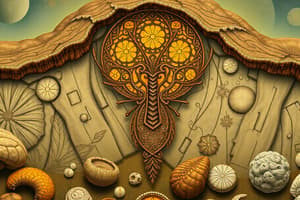Podcast
Questions and Answers
Which of the following conditions characterized early Earth, according to the provided information?
Which of the following conditions characterized early Earth, according to the provided information?
- An atmosphere rich in free oxygen
- Frequent impacts of meteorites and intense gravity (correct)
- Abundant, complex life forms
- A stable climate with moderate temperatures
The Miller-Urey experiment demonstrated that life spontaneously originated on early Earth.
The Miller-Urey experiment demonstrated that life spontaneously originated on early Earth.
False (B)
Outline one of the critical steps necessary for life to exist on Earth, as mentioned in the text.
Outline one of the critical steps necessary for life to exist on Earth, as mentioned in the text.
Abiotic synthesis of organic molecules
What major event in the history of life on Earth is associated with the endosymbiotic hypothesis?
What major event in the history of life on Earth is associated with the endosymbiotic hypothesis?
The method of determining the age of rocks and fossils using the decay of radioactive isotopes is known as ________ dating.
The method of determining the age of rocks and fossils using the decay of radioactive isotopes is known as ________ dating.
Match the external feature with its description regarding prokaryotes:
Match the external feature with its description regarding prokaryotes:
What is the significance of endospores in prokaryotic survival?
What is the significance of endospores in prokaryotic survival?
Biofilms always pose a direct and immediate danger to human health.
Biofilms always pose a direct and immediate danger to human health.
Give an example of how prokaryotes are used to address a need in human society.
Give an example of how prokaryotes are used to address a need in human society.
Which of the following is a key difference between Archaea and Bacteria?
Which of the following is a key difference between Archaea and Bacteria?
Bacterial ________ involves the uptake of DNA from the surrounding environment, while ________ involves the transfer of DNA between bacteria via a phage.
Bacterial ________ involves the uptake of DNA from the surrounding environment, while ________ involves the transfer of DNA between bacteria via a phage.
Match the kingdom to their mode of nutrition:
Match the kingdom to their mode of nutrition:
Which of the following challenges did plants face when transitioning to terrestrial environments?
Which of the following challenges did plants face when transitioning to terrestrial environments?
Gymnosperms are the only plants that have vascular tissue to transport water and nutrients, but do not produce seeds.
Gymnosperms are the only plants that have vascular tissue to transport water and nutrients, but do not produce seeds.
Describe one of the key features associated with angiosperms.
Describe one of the key features associated with angiosperms.
Which part of the flower eventually encloses the ovules?
Which part of the flower eventually encloses the ovules?
Fruits function to aid in spreading the ________.
Fruits function to aid in spreading the ________.
Match the characteristics with either Monocots or Dicots.
Match the characteristics with either Monocots or Dicots.
Which of the following describes a beneficial role that fungi play?
Which of the following describes a beneficial role that fungi play?
Lichens are an example of symbiosis with bacterial hyphase.
Lichens are an example of symbiosis with bacterial hyphase.
Flashcards
Early Earth Conditions
Early Earth Conditions
Early Earth was very hot and had a high impact of meteorites and gravity.
Miller-Urey Experiment
Miller-Urey Experiment
The Miller-Urey experiment tested the hypothesis that organic molecules could be created on early Earth spontaneously.
Steps to Life's Existence
Steps to Life's Existence
The four steps necessary for the existence of life on Earth includes: Abiotic synthesis, Polymerization, Packaging into protocells, and Self-replication.
Radiometric Dating
Radiometric Dating
Signup and view all the flashcards
What is Metagenomics
What is Metagenomics
Signup and view all the flashcards
Biofilm definition
Biofilm definition
Signup and view all the flashcards
Exotoxins vs. Endotoxins
Exotoxins vs. Endotoxins
Signup and view all the flashcards
Halophiles vs. Thermophiles
Halophiles vs. Thermophiles
Signup and view all the flashcards
Plant Autotrophy
Plant Autotrophy
Signup and view all the flashcards
Bryophyte Characteristics
Bryophyte Characteristics
Signup and view all the flashcards
Vascular Seedless Plants
Vascular Seedless Plants
Signup and view all the flashcards
Gymnosperm Seeds
Gymnosperm Seeds
Signup and view all the flashcards
Angiosperm Reproduction
Angiosperm Reproduction
Signup and view all the flashcards
Sepal and Petal Functions
Sepal and Petal Functions
Signup and view all the flashcards
Stamen and Carpel Roles
Stamen and Carpel Roles
Signup and view all the flashcards
Fruit Function
Fruit Function
Signup and view all the flashcards
Fungi Characteristics
Fungi Characteristics
Signup and view all the flashcards
Symbiosis
Symbiosis
Signup and view all the flashcards
What are lichens
What are lichens
Signup and view all the flashcards
Study Notes
Unit 6.1: Tracing Evolutionary History
- Early Earth was very hot due to the impact of meteorites and the compactness of gravity
- The Miller-Urey experiment tested if organic molecules could be created on early Earth; its findings support that life evolved on Earth spontaneously
Steps Necessary for Life
- Abiotic synthesis of organic molecules occurs
- Monomers join into polymers
- Polymers are packaged into protocells
- RNA self-replicates, leading to inheritance
History of Life on Earth
- The endosymbiotic hypothesis explains the generation of mitochondria and chloroplasts in the evolution of eukaryotic cells
Radiometric Dating
- Radiometric dating and the relative position of a fossil within rock strata help determine the age of rocks
- Radiometric dating is based on the decay of radioactive isotopes
Steps of Radiometric Dating
- List and practice the steps in the process of radiometric dating
- Interpret a half-life graph
Origin of Prokaryotes
- The earliest prokaryotes are stromatolites
- Prokaryotes were the sole inhabitants from 3.5 to 2 billion years ago
- Prokaryotic photosynthesis led to oxygen saturation of the seas, and appeared 2.7 billion years ago
- 2.2 billion years ago, O2 increased rapidly
- Most prokaryotes went extinct, but some lived in anaerobic environments
- Cellular respiration allowed other prokaryotes to survive
Origin of Single-Celled Eukaryotes
- Originating 1.8 billion years ago
- Small prokaryotic cells took up life inside larger cells
- Many unicellular forms evolved after they appeared
Origin of Multicellular Eukaryotes
- Algae, plants, fungi, and animals
- The first algae appeared 1.2 billion years ago
- Larger and more diverse organisms appeared 600 million years ago
Cambrian Explosion
- A period of time where the diversity of animals greatly increased
Colonization of Land
- Prokaryotes covered land a billion years ago
- Large forms of life appeared 500 million years ago
- Plants colonized in the company of fungi
- Most plants still have fungi in roots that aid in absorption of water and minerals
- Fungi receive nutrients in return
- Arthropods (insects) and tetrapods (vertebrates with 4 appendages) are the most widespread and diverse land animals
Elements and Isotopes
- Fossils contain isotopes of elements that accumulated when organisms were alive
- Once an organism dies, the isotope decays
- The rate of decay is considered the half-life
- Knowing the half-life of an isotope and the ratio to the stable isotope lets us determine the age of a fossil
- A longer half-life is used to date older fossils
- A lower half-life is used to date younger fossils
Unit 6.2: Bacteria and Protists - Prokaryotic Life
Diversity and Importance
- There are 10 times more prokaryotes than eukaryotes
- Metagenomics collects samples from specific environments and isolates/sequences DNA
- Microbiome computer software assembles collections of genomes of one species in a given environment
- Human microbiome: Trillions of microorganisms living on/within the body
- Impacts: digestion, immune function, metabolism, and mental well-being
Prokaryote External Features
- Shapes include cocci, bacilli, and spirochetes
- Streptococci causes strep throat
- Staphylococcus, which is a cluster
Cell Wall
- All prokaryotes live in a wide range of environments
- Cell walls provide physical protection and prevent bursting
Gram Staining
- Differentiates bacteria based on cell wall structure
- Gram-positive bacteria have simpler walls with a thick layer of peptidoglycan
- Gram-negative bacteria have less peptidoglycan and are more complex, containing an outer membrane with lipids
Projections
- External structures extend beyond the cell wall, such as flagella and fimbriae
Prokaryote Success Adaptations
- Endospores are developed when the environment is too harsh for a prokaryote to reproduce in the long run
Nutritional Diversity
- Photoautotrophs harness sunlight and use CO2 for carbon
- Photoheterotrophs obtain energy from sunlight but get carbon from organic sources
- Chemoautotrophs harvest energy from inorganic chemicals and use carbon from CO2 to make organic molecules
- Chemoheterotrophs acquire energy and carbon from organic molecules; the most diverse group of prokaryotes
Biofilms
- Consist of one or several species of prokaryotes, including protists and fungi forming highly organized colonies
- Common in bacteria that cause disease in humans like ear and urinary tract infections
Biofilm in Cystic Fibrosis
- Cystic fibrosis patients are vulnerable to pneumonia caused by biofilm-creating bacteria
Toxins
- Exotoxins are proteins secreted by bacterial cells into the environment and can cause major diseases when entering through a wound
- Endotoxins are lipid components of the outer membrane of gram-negative bacteria that are released when the cell dies, potentially causing septic shock
Addressing Human Needs
- Bioremediation uses organisms to remove pollutants from soil or water
- Useful for cleaning up toxic chemicals released into soil and water
Domains of Life: Differences in Cellular and Biochemical Traits
- Refer to Table 16.7 for differences between Bacteria, Archaea, and Eukarya
Archaea
- Extreme halophiles thrive in salty places
- Extreme thermophiles thrive in hot water
Bacterial Genetic Variation
- Transformation: The cell takes up DNA from the environment
- Transduction: Genes are transferred between bacteria and viruses
- Conjugation: Genes are directly transferred from one bacterium to another
Unit 6.3: Plants & Fungi
Plant vs Fungi
- Plants are autotrophic, making their own food through photosynthesis
- Fungi are heterotrophic, obtaining nutrients by absorbing organic matter
Challenges of Terrestrial Life
- Maintaining moisture
- Aboveground parts of most land plants have a waxy cuticle which prevents water loss
- Obtaining resources from two locations
- Adaptations: roots, stems, and leaves all aid in getting water/mineral nutrients in the soil or light/CO2 in the ground
Bryophytes
- Resemble other plants in having apical meristems and embryos that are retained on the parent plant, but lack true roots/leaves (ex: mat of moss)
Vascular Seedless Plants
- Have vascular tissue to transport water and nutrients but do not produce seeds (ex: ferns)
Gymnosperms
- Have "naked" seeds and are the earliest seed plants (ex: ornamental ginkgo tree)
Angiosperms
- Flowering plants that have complex reproductive structures that develop seeds within protective chambers (ex: flowering trees/shrubs)
Plant Life Cycle and Alternation of Generations
- Refer to the plant life cycle diagram for details on the alteration of generations
Parts of a Flower
- Sepals: Enclose the flower before it opens
- Petals: Attract animal pollinators
- Stamens: Produce pollen which house reproductive structure
- Anther: Contains male sporangia
- Carpels: female reproductive stricture
- Ovary: Angiosperm adaptation that encloses ovules
- Each ovule contains a sporangium that will produce a female gametophyte and will eventually become a seed
Fruits
- Ripened ovary of a flower is an adaptation to help disperse seeds
Monocots vs Dicots
- Refer to the diagram for differences between monocots and dicots
Fungi Characteristics
- Eukaryotic and heterotrophic
Economic Importance
- Beneficial fungi : truffles/cheeses are foods, and actinomycetes produces antibiotics
- Harmful fungi cause parasitism/pathogens
Symbiosis
- A close relationship between two or more different species of organisms
- Lichens are symbiotic with fungal hyphae
Studying That Suits You
Use AI to generate personalized quizzes and flashcards to suit your learning preferences.




